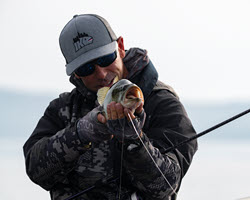
If you’re a hard core bass angler, you probably don’t stop fishing just because the water is cold, and you know that one of the best wintertime categories of lures is typically referred to as “metal.” That describes them perfectly, because all of them are simply a hunk of metal shaped to resemble a baitfish. They are the deal when the water is cold, and start to become a player when the water is mid-50s or lower.
You’re doing yourself a disservice if you don’t have at least one tied on under the right conditions, but it’s also critical to have the right one tied on. I’m going to simplify my system for you by giving you four baits from three categories that’ll cover almost any scenario. I pick them depending on the zone of where the fish are living: Is there a horizontal bottom? A vertical bottom? Or a tapered bottom? That’s how I break it down.
Let’s start with horizontal bottom scenarios. Believe it or not, bass will live in these scenarios in cold water. The easiest for most of us to envision is a deep, relatively featureless flat. It doesn’t have to have a break, but it should be near deep water. A good example is a place that is 20 feet deep for a long way but near a channel that drops into 40 or 50 feet. These types of areas are especially good on warm days. The problem is that because they don’t have a break to focus on, you need to cover water. That’s why I choose a blade bait in this instance.

Blades are an old and comparatively simple category of lures, basically a hunk of metal with a split ring or snap in the middle. I like the modernized Molix Trago Vib. You fish them like you’d fish a lipless crankbait: Cast it out, let it hit the bottom, and then make short yo-yo hops back to the boat.
But what about tapered banks, places with a drop-off? I love to fish 45-degree banks this time of year. It could be a channel swing, the place where a main lake point drops off into the channel, a riprap, a dam or a causeway. In these situations, you need to stay in contact with the taper but also attract fish. I use the good old tail spinner, a pill-shaped piece of heavy metal with a blade on the back. I add a treble hook. Again, this is a category of lure that’s been around in primitive forms, and I prefer the modernized Molix Spin Tail.

With the tailspinner, you cast it so that it lands on the shallow part of the taper and then make little tiny hops and drops back to the boat. You want to move your rod from about 2 o’clock to 12 o’clock. As the lure rises and falls, the spinner turns and the lure looks like a dying or struggling baitfish. The bass can’t stand it.
Last but not least, let’s address what most people consider a key zone to fish when it’s cold out: Vertical banks! I’m talking about places that are straight up and down, like deep seawalls, the face of a dam, or bluff banks. Deep docks in a marina probably qualify, too. In these situations, I just want my bait to go straight up and down. There’s no covering water, no following a taper.

This is the one category where I need two lures to cover my bases. The first is a traditional spoon. You may have heard them called “jigging spoons” or “slab spoons.” It’s a fish-shaped piece of metal with a treble hook. I like the one that Molix makes. The second lure is the Rapala Jigging Rap, which is a crazy sleeper in the bass world. It has a single hook on each end, a treble dangling from the middle, and a little fin to make it glide. Some days the fish will prefer the action of one of these and other days they’ll want the other, so keep them both on the deck of your boat.

This is a style of fishing, where my graph becomes my friend. When you’re fishing a piece of cover like a bluff or a bridge piling, the bass aren’t always sitting directly on the bottom. They’re often suspended. My Lowrance down-imaging allows me to see the level of the fish and the bait and then drop my lure directly into their faces. Once I get it down to their level, I’ll move my rod from 3 o’clock to 12 and then send the lure back down again on a semi-slack line.
I hope that this explanation of the different types of metal, and where to use them, was helpful. Cold weather may not always be comfortable, but it’s a great time to find fish bunched up and to catch some giants, and these types of lures are often the best tools for the job.
______________________________________________________________________________
Like Ike on Facebook, and follow him on Instagram and Twitter to see weekly Vlogs for Going Ike episode, along with fishing and fun content.
Subscribe to Mike’s YouTube channel, Going Ike, to ensure you see every adventure video.
Return to Mike Iaconelli’s website